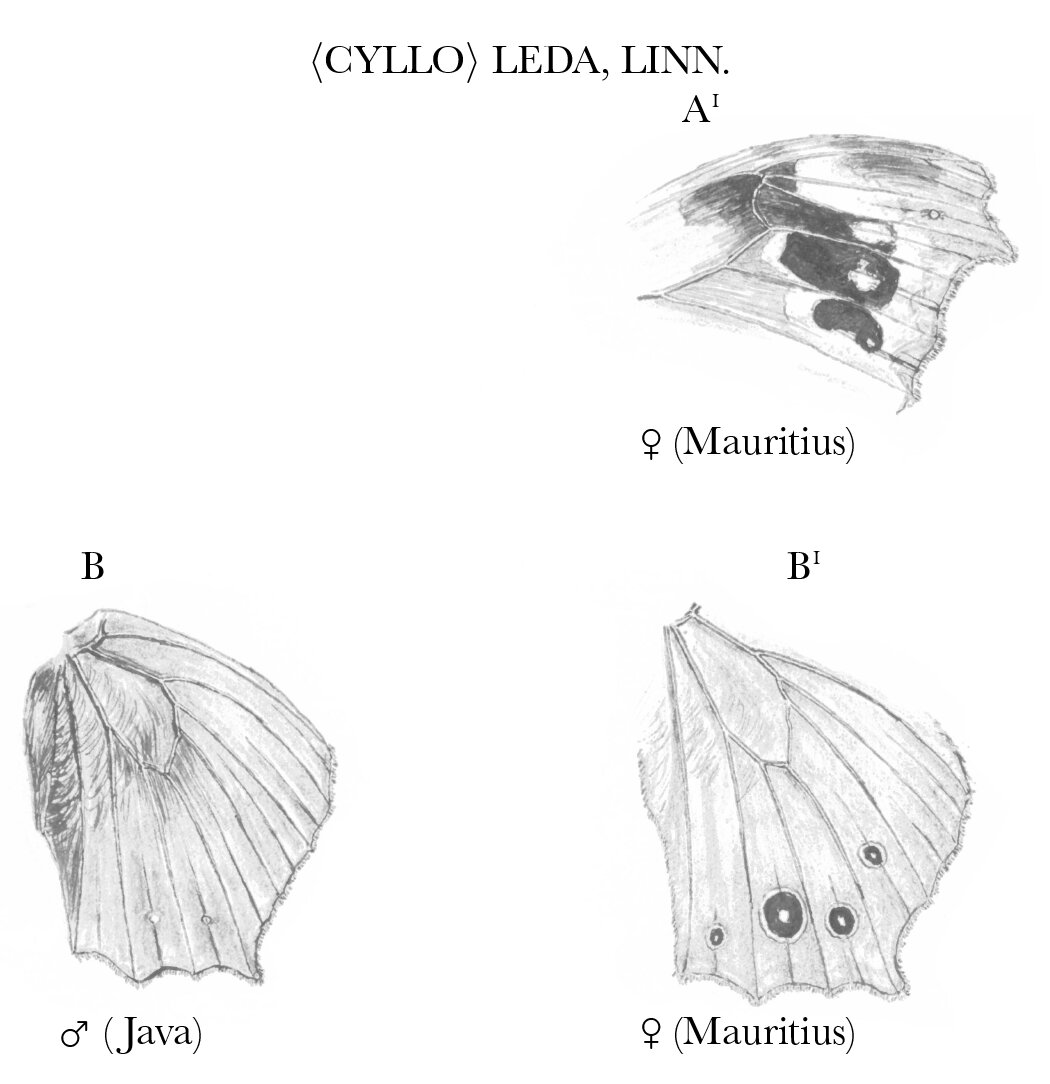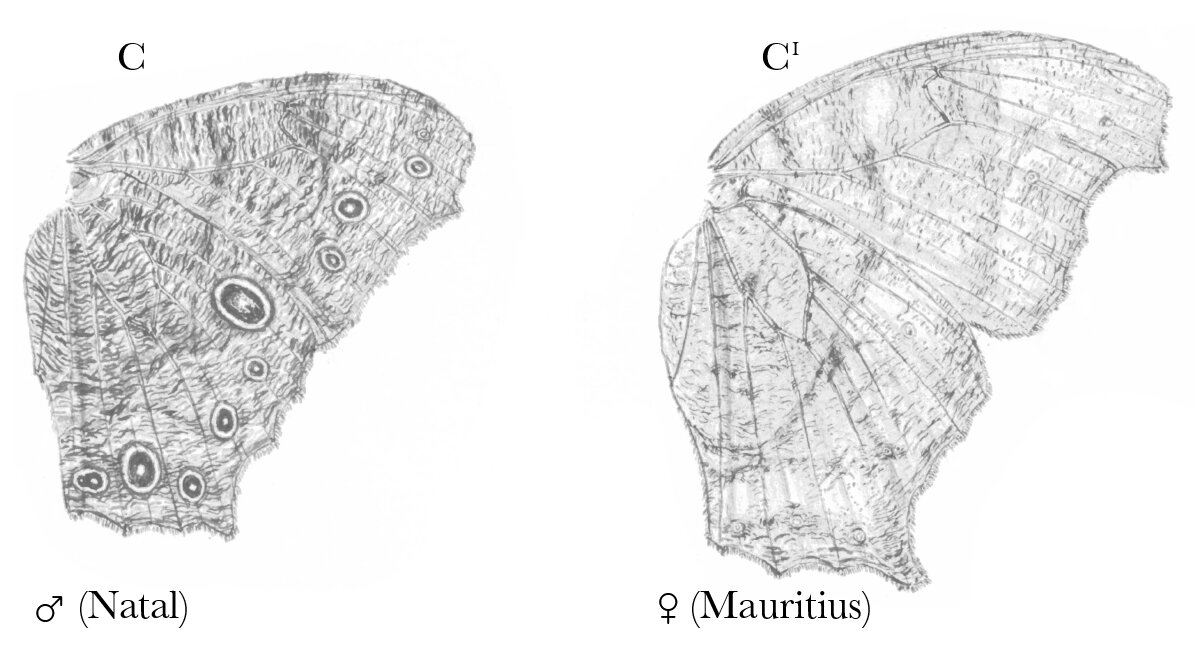From Roland Trimen 13 January 1868
71, Guildford Street, | Russell Square | London. W.C.
13th. January, 1868.
My dear Mr. Darwin,
I have the pleasure of enclosing a sketch of the best case of variation in ocelli that I have been able to discover among the Lepidoptera.1
The drawings have been carefully made, by measurement, from specimens in my own collection, and you may rely upon their being tolerably exact.
Cyllo Leda is a butterfly so extremely subject to variation in the form, colouring, and marking of the wings, that I thought it not unlikely that the long series in the British Museum might contain examples exhibiting a still wider difference in the ocelli than could be found among my own specimens; but, since the Museum has been re-opened, I have looked through the series without finding any more striking instances than those which I have figured.
I forward an old proof of that portion of Part 2 of my Catalogue of S. African Butterflies which refers to C. Leda, in order to give you some idea of the colouring, as well as of the wide geographical range of the species.2
The tendency of this butterfly to vary is not only very strong, but seems to work at random, as it were. The differences in outline of the forewing distinguish neither the sexes, nor specimens from different localities; and the same may be said of the varying colours and markings. I have ♂ examples from the very same spot (a wood edging the Botanic Gardens at Port Natal)3 ranging from the straight hindmargin & faint, dingy colouring of Fig. A,4 to as falcate a form, and as rich decided hues, as those shown by the ♀ figured (AI).
Specimens which have the ocelli very large & strongly-marked on the upperside are often found with the underside ocelli minute and faintly defined (e.g. Fig. A.I, which has the ocelli of the inferior surface not much larger than those of Fig. CI); and vice versa (e.g. Fig. C, which is almost like Fig. A on the upperside, and has only one ocellus in the hindwing.)5
It is rare to find the 3rd. (lowest) ocellus in the forewing of the ♀, shown in Fig. AI, the two confluent ocelli being the rule, though a few specimens exhibit rudimentary traces of a third.
The proof I send will, I think, sufficiently inform you as to the wonderful variation in the colouring of the underside; but, even on the upperside, the variation is considerable, the fulvous ranging from the very indistinct bar inwardly bordering the ocelli in Fig. A, to the clear rich colouring surrounding the ocelli in Fig. AI., which also more or less suffuses all the upper surface.
The family (Satyridæ) to which the butterfly belongs, is one in which nearly all the genera consist of ocellated species; and I think I shall be supported by lepidopterists in the statement that there is no character of mere marking or coloration so unstable as the ocelli, both in number and size.6 The species of Mycalesis are particularly noticeable for variation in this respect.7
I have not as yet found any good case of progressive variation in the ocelli in any genus, though I am under the impression that such exist.
The most distinguished family for ocelli among the Moths is the Saturniidæ, of which our English “Emperor Moth” is a familiar example.8 One large South African species, Gynanisa Isis, has the hindwing ocellus occupying nearly the whole of the central portion of the wing, & consisting of 9 distinct rings, viz: black (large centre, with semi-transparent crescent), 1 ochre-yellow, 2 black, 3 ochre-yellow, 4 pink, 5 white, 6 pink, 7 brown, & 8 whitish.9 The ocellus of forewing in this species is small, & consists of but 3 rings (incomplete) viz: black, pink & white. In most of the S. African Saturniidæ the ocellus of forewing is much smaller than that of hindwing, & often represented only by an irregularly-shaped transparent mark; but in Saturnia Apollonia the reverse is the case, the ocellus of the anterior wing being considerably larger than that of the posterior.10 But I have not found much variation within the limits of a species among the Saturniidæ.
Believe me, with sincere regard, | Very faithfully yours | Roland Trimen
[Enclosure]


RT. delt.11
| VARIATION OF OCELLI. | ||||
| A, AI, | Extreme range | of ocelli on | upper surface of | fore-wings |
| B, BI, | Do. | do. | do. | hind-wings |
| C, Cr, | Do. | do | under surface of | fore-and hind-wings. |
CD annotations
Footnotes
Bibliography
Calendar: A calendar of the correspondence of Charles Darwin, 1821–1882. With supplement. 2d edition. Edited by Frederick Burkhardt et al. Cambridge: Cambridge University Press. 1994.
Columbia gazetteer of the world: The Columbia gazetteer of the world. Edited by Saul B. Cohen. 3 vols. New York: Columbia University Press. 1998.
Descent 2d ed.: The descent of man, and selection in relation to sex. By Charles Darwin. 2d edition. London: John Murray. 1874.
Descent: The descent of man, and selection in relation to sex. By Charles Darwin. 2 vols. London: John Murray. 1871.
McCracken, Donal P. 1997. Gardens of empire: botanical institutions of the Victorian British empire. London and Washington: Leicester University Press.
Trimen, Roland. 1862–6. Rhopalocera Africæ Australis; a catalogue of South African butterflies, comprising descriptions of all the known species with notices of their larvæ, pupæ, localities, habits, seasons of appearance, and geographical distribution. London: Trübner. Cape Town, South Africa: W. F. Mathew.
Summary
Variations in the ocelli of Lepidoptera.
Encloses six pages from his catalogue of S. African butterflies [Rhopalocera Africae australis, 2 pts (1862, 1866)].
Letter details
- Letter no.
- DCP-LETT-5785
- From
- Roland Trimen
- To
- Charles Robert Darwin
- Sent from
- London, Guildford St, 71
- Source of text
- DAR 84.1: 40–2, 168
- Physical description
- ALS 4pp †
Please cite as
Darwin Correspondence Project, “Letter no. 5785,” accessed on
Also published in The Correspondence of Charles Darwin, vol. 16


